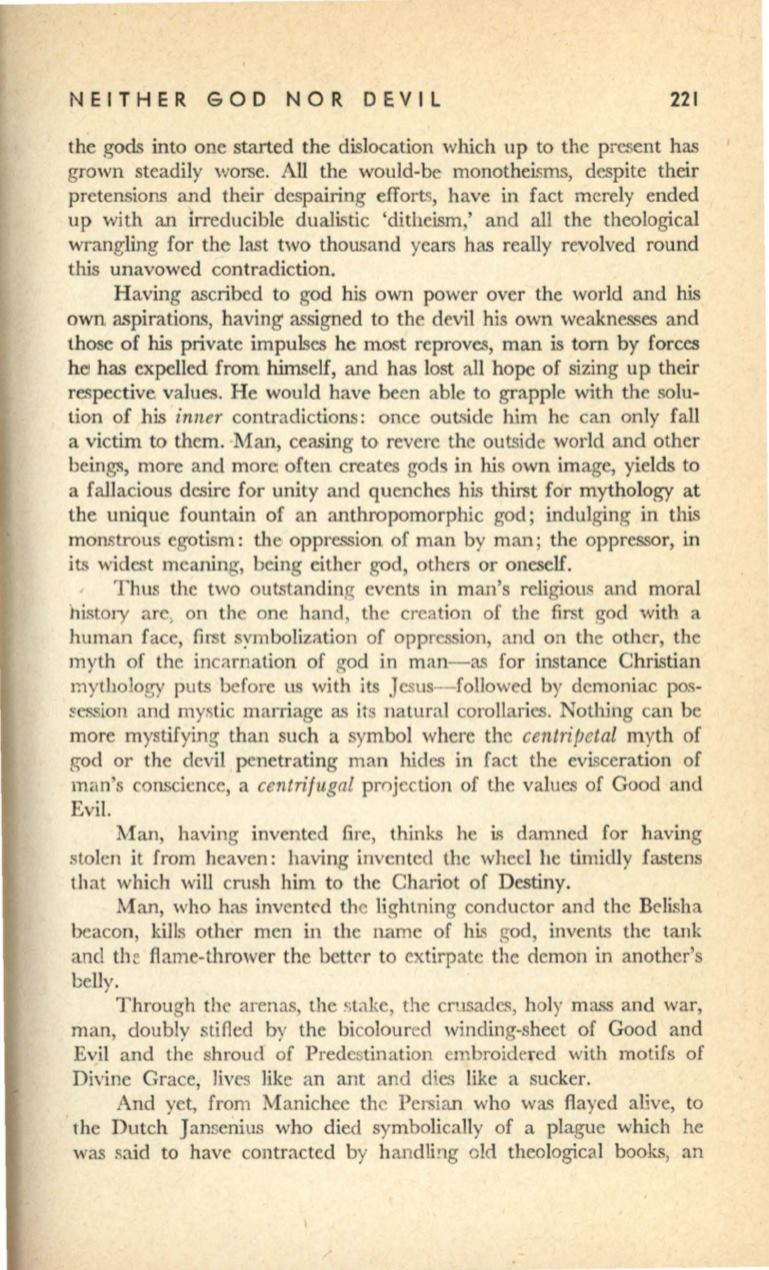
NEITHER GOD NOR DEVIL
221
the gods into one started the dislocation which up to the present has
grown steadily worse. All the would-be monotheisms, despite their
pretensions and their despairing efforts, have in fact merely ended
up with an irreducible dualistic 'ditheism,' and all the theological
wrangling for the last two thousand years has really revolved round
this unavowed contradiction.
Having ascribed to god his own power over the world and his
own aspirations, having assigned to the devil his own weaknesses and
those of
his
private impulses he most reproves, man is tom by forces
he! has expelled from himself, and has lost all hope of sizing up their
respective values. He would have been able to grapple with the solu–
tion of bis
inner
contradictions: once outside him he can only fall
a victim to them. Man, ceasing to revere the outside world and other
beings, more and more often creates gods in his own image, yields to
a fallacious desire for unity and quenches his thirst for mythology at
the unique fountain of an anthropomorphic god; indulging in this
monstrous egotism: the oppression of man by man; the oppressor, in
its widest meaning, being either god, others or oneself.
Thus the two outstanding events in man's religious and moral
histmy are, on the one hand, the creation of the first god with a
human face, first symbolization of oppression, and on the other, the
myth of the incarnation of god in man-as for instance Christian
mythology puts before us with its Jesus-followed by demoniac pos–
~ession
and mystic marriage as its natural corollaries. Nothing can be
more mystifying than such a symbol where the
centripetal
myth of
god or the devil penetrating man hides in fact the evisceration of
man's conscience, a
centrifugal
projection of the values of Good and
Evil.
Man, having invented fire, thinks he
i'>
damned for having
stolen it from heaven: having invented the wheel he timidly fastens
that which will crush him to the Chariot of Destiny.
Man, who has invented the lightning conductor and the Belisha
beacon, kills other men in the name of his god, invents the tank
and the flame-thrower the bettrr to extirpate the demon in another's
belly.
Through the arenas, the stake, the crusades, holy mass and war,
man, doubly stifled by the bicoloured winding-sheet of Good and
Evil and the shroud of Predestination embroidered with motifs of
Divine Grace, lives like an ant and dies like a sucker.
And yet, from Manichee the Persian who was flayed alive, to
the Dutch Jansenius who died symbolically of a plague which he
was said to have contracted by handling old theological books, an


